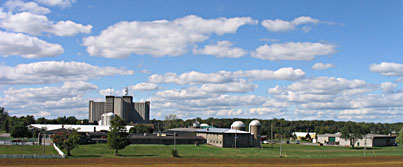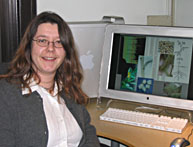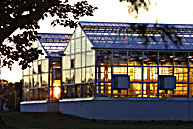Macdonald campus: All's busy on the western front
Macdonald campus: All's busy on the western front McGill University
User Tools (skip):

HCR photos
Macdonald Campus: All's busy on the western front
For the past 60 years, an ever-expanding suburbia has been wrapping its tendrils around the 650-hectare site that houses McGill's Faculty of Agriculture and Environmental Sciences in Ste. Anne de Bellevue. It is this encroaching urbanization that makes a visit to the bucolic campus with its barns, fields and orchards such a treat.
It's true that city-weary visitors to the Mac Campus will find a soothing place in which to shrug off the stresses of urban life. But this is no sleepy setting: it's a hive of cutting-edge scientific research.

Plant Sciences professor Martina Stromvik
HCR photos
Macdonald College was created in 1907 by Sir William Macdonald to improve the lives of rural people in Quebec, said Deborah Buszard, dean of the agricultural and environmental sciences faculty, in a recent interview. A century later, the vocation is the same but the methods of fulfilling it have changed dramatically. "If you look at what was being done here almost 100 years ago, it was cutting edge for its time," Buszard said. "Our work is still cutting edge."
The original mission of Macdonald College (now the Faculty of Agriculture and Environmental Sciences) was to improve the quality of life of people in rural areas through research, the teaching of scientific agriculture, the training of teachers for rural schools and the teaching of household sciences. "Women in rural areas in the late 19th century had little access to information about nourishment and children's diseases," Buszard said. So household sciences became one of the three academic streams at Mac, along with agriculture and teacher training.

Professor Kevin Wade's dairy information systems lab
"Sir William Macdonald, while serving as a member of the board of directors of the Bank of Montreal, had observed that in rural areas where people had taken up dairy farming, the local economy improved," Buszard said. "Other regions where farmers were just raising fodder for horses (the means of transportation then) were not doing as well. Dairy farming led to the production of cheese and butter and it added value to the local communities. Sir William observed the relationship between the emergence of the dairy industry and improvements in the standard of living of rural communities and decided that providing agricultural education and new knowledge would be a way to improve the quality of life in rural areas. Today, we're still working on Canadian farm issues, just differently."
"Differently" is clearly an understatement. New science and technologies have revolutionized the way the faculty works. One case in point is the Quebec Dairy Herd Analysis Service, now known by its French acronym, PATLQ, created in 1966 by Macdonald professor John Moxley. It collects and analyzes milk samples from dairy herds and processes data to help farmers certify and manage their herds and to improve breeding and milk production. "In the past 40 years, we've doubled the productivity of dairy herds in Canada because we understand the components of yield," Buszard said.

HCR photos
"Four years ago, Professor Kevin Wade was awarded a CFI (Canada Foundation for Innovation) grant to create a dairy information systems laboratory here to analyze the herd data and to look at the components of productivity in cattle," she said. "Farmers can use this information to make better decisions."
The disciplines in which the faculty is active -- agriculture, environment, food, nutrition and parasitology -- have been transformed by the biosciences revolution and the development of biotechnology and bioinformatics. Asked when that shift began, Buszard says it's been evolutionary but cites 1953, the year the double helix structure of DNA was discovered, as a pivotal date. "In the '60s and '70s, we were beginning to understand how genes work. It was a window that opened up, but what we needed to make it happen was technology, which would make it possible to work at the genome level. That started to come in the '80s."
By the early '80s, researchers on the Mac Campus were engaged in the beginnings of biotechnology.
Consider barley's place in this picture. When the college was founded, barley was not much cultivated as animal feed, Buszard said. "Today we have a barley breeder on staff, Professor Diane Mather, who is a leader in the North American Barley Genome Project, which has mapped the barley genome. Her interest is in the genes affecting malting characteristics."

Owen Egan
Parallel to scientific developments, she said, there's been a growth in analytical techniques, led by bioinformatics. For the uninitiated, bioinformatics is a marriage of biology and computational science, allowing researchers to scrutinize biological data using information technology. Professor Martina Stromvik of the Department of Plant Sciences applies bioinformatic techniques to crop plants. "Bioinformatics lets us look at organisms at the level of the individual nucleotides that make up the genes on chromosomes," says Buszard. "We're just at the beginning of being able to look at genetic material in this way."
The faculty has always been an active player in the environmental domain. "The Department of Bioresource Engineering began in 1918 as a department of agricultural engineering, working on farm machinery, farm buildings, irrigation and drainage. Today, it encompasses food and bioprocess engineering, water resource management and environmental engineering," she said.
The Brace Centre for Water Resources Management works around the world on water management. "It's a global issue," Buszard said. "About 20 percent of the world's population does not have access to clean water. Thirty thousand people die every day from water-related illnesses. Members of the Brace Centre work in Asia, Africa and the Caribbean, assisting countries to develop water management strategies. McGill provides advice, training and consultation on best practices."
Brace researchers are also working to restore the depleted Aral Sea, once the fourth largest inland sea on the planet, wedged between Kazakhstan and Uzbekistan. It's been reduced by one third in the past 30 years by the damming of its feeder rivers for irrigation. "These kinds of projects provide a wonderful learning opportunity for our students," Buszard said.
Today, the faculty views its mission to improve the lives of rural people as a global mandate. In southern India, for instance, Professor Vijaya Raghavan is working with subsistence farmers to preserve the crops they grow so that they can transport their products to markets. "This will enable them to trade surplus crops, increase economic activity for their villages and raise their standard of living," Buszard said.
"Our mission is as relevant today as it was 100 years ago," she said. "We are still working to improve the lives of rural people."
